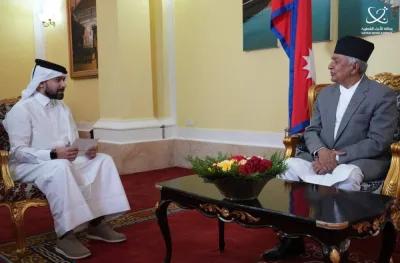Experts at Qatar Foundation (QF) have proposed a dynamic web-based sustainability dashboard for corporate buildings in the country to monitor, categorise and report energy consumption as a means to combat climate change.
“Energy efficiency is one of the most powerful tools for combating global climate change. The equation is straightforward: less energy used, means less emissions generated,” said principal scientist at Qatar Environment and Energy Research Institute (Qeeri), part of QF’s Hamad Bin Khalifa University.
Buildings alone account for approximately 32% of global energy use, and nearly 30% of total greenhouse gas emissions. This essentially means there is lots of room for improvement when it comes to their energy efficiency.
“The problem is even more serious here with buildings accounting for the largest portion of total electricity consumption. In 2020, buildings in Qatar consumed over 50% of the total electricity generated,” said, Dr Beitelmal.
According to Mohammed Ayoub, a senior research director at Qeeri, the urgency of climate change necessitates decisive action across all sectors, including building energy consumption.
“If building operators in Qatar adopt this proposed sustainability dashboard to track their detailed energy consumption and use this information to map clear reduction targets, they will see immediate and noticeable improvements in their energy efficiency. This, in-turn, will translate into significant reductions in building carbon footprint across the country,” he explained.
A sustainability dashboard would allow more environmentally-conscious organisations in the country to cement their commitment to the environment while encouraging others to follow suit.
“Think of the dashboard as an energy report card. It will detail exactly where the energy is being used and how much. What we get is overall energy consumption of the building; however, the challenge with this is, it doesn’t categorise the consumption,” said, Dr Beitemal.
The advantage of categorised energy consumption readings is that it will allow to identify which areas need to be prioritised when implementing energy efficiency measures.
“A building can be designed to be sustainable, but that doesn’t mean it will automatically become energy efficient. This is where the dashboard will come in by offering a granular overview of the building’s energy consumption and uncovering which areas need to be made more efficient,” continued, Dr Beitemal.
The experts noted that to get this off the ground, will require great effort. “It might be that some buildings don’t actually record the necessary data, but that doesn’t mean they can’t. The other challenge with such initiatives is that people might think of it as an energy audit that would highlight their energy inefficiency and reflect negatively on them,” maintained, Ayoub.
Several institutions in North America have implemented sustainability dashboards with success. The ability of such a dashboard to show clear data on what is really going on, allows users to make effective data-driven decisions and see their impact on energy efficiency in real-time.
Dr Beitelmal said: “I personally think, QF has everything it needs to get the ball rolling on this. We have the infrastructure, the engineers, the scientists, and most importantly the vision to become leaders in sustainability.”
“The important thing to remember for corporations here is, instead of looking at it as an expose which will uncover shortcomings, we need to look at it as a learning process that offers us the opportunity to improve our energy efficiency,” added, Dr Beitelmal.
“Energy efficiency is one of the most powerful tools for combating global climate change. The equation is straightforward: less energy used, means less emissions generated,” said principal scientist at Qatar Environment and Energy Research Institute (Qeeri), part of QF’s Hamad Bin Khalifa University.
Buildings alone account for approximately 32% of global energy use, and nearly 30% of total greenhouse gas emissions. This essentially means there is lots of room for improvement when it comes to their energy efficiency.
“The problem is even more serious here with buildings accounting for the largest portion of total electricity consumption. In 2020, buildings in Qatar consumed over 50% of the total electricity generated,” said, Dr Beitelmal.
According to Mohammed Ayoub, a senior research director at Qeeri, the urgency of climate change necessitates decisive action across all sectors, including building energy consumption.
“If building operators in Qatar adopt this proposed sustainability dashboard to track their detailed energy consumption and use this information to map clear reduction targets, they will see immediate and noticeable improvements in their energy efficiency. This, in-turn, will translate into significant reductions in building carbon footprint across the country,” he explained.
A sustainability dashboard would allow more environmentally-conscious organisations in the country to cement their commitment to the environment while encouraging others to follow suit.
“Think of the dashboard as an energy report card. It will detail exactly where the energy is being used and how much. What we get is overall energy consumption of the building; however, the challenge with this is, it doesn’t categorise the consumption,” said, Dr Beitemal.
The advantage of categorised energy consumption readings is that it will allow to identify which areas need to be prioritised when implementing energy efficiency measures.
“A building can be designed to be sustainable, but that doesn’t mean it will automatically become energy efficient. This is where the dashboard will come in by offering a granular overview of the building’s energy consumption and uncovering which areas need to be made more efficient,” continued, Dr Beitemal.
The experts noted that to get this off the ground, will require great effort. “It might be that some buildings don’t actually record the necessary data, but that doesn’t mean they can’t. The other challenge with such initiatives is that people might think of it as an energy audit that would highlight their energy inefficiency and reflect negatively on them,” maintained, Ayoub.
Several institutions in North America have implemented sustainability dashboards with success. The ability of such a dashboard to show clear data on what is really going on, allows users to make effective data-driven decisions and see their impact on energy efficiency in real-time.
Dr Beitelmal said: “I personally think, QF has everything it needs to get the ball rolling on this. We have the infrastructure, the engineers, the scientists, and most importantly the vision to become leaders in sustainability.”
“The important thing to remember for corporations here is, instead of looking at it as an expose which will uncover shortcomings, we need to look at it as a learning process that offers us the opportunity to improve our energy efficiency,” added, Dr Beitelmal.




